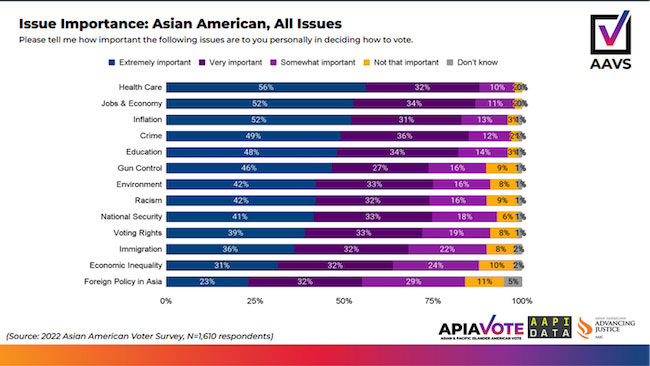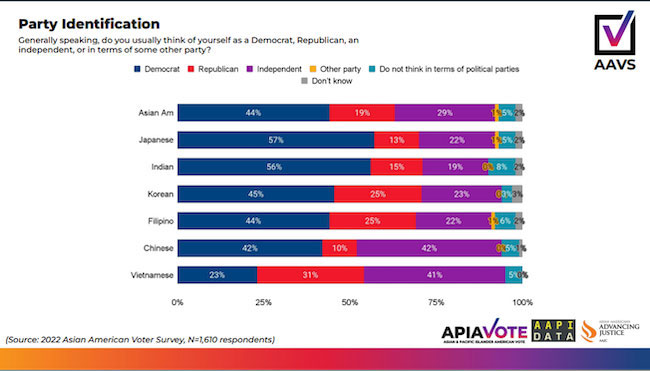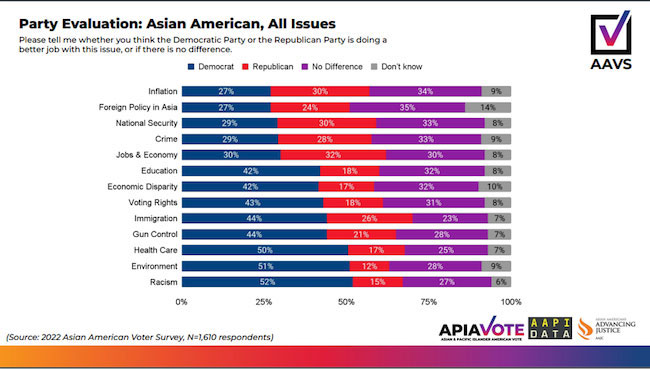Fast-growing and ready to vote
Editor's note: Brittany Chiu is a research analyst with Sparkle Insights. She can be reached at brittany@sparkleinsights.com.
The 2020 election cycle and the 2022 midterm election exit polls proved that there is much untapped potential among the fast-growing Asian American voting bloc. Those who do not pay enough attention to them risk losing out in the future.
According to the U.S. Census, the Asian American population, whether alone or racially combined, grew 38.6% from 2010 to 2020, and now represents approximately 7% of the total population. Thanks also to a 9% increase in voter eligibility since 2018, more than 13.3 million Asian Americans are 18 and older and able to vote.
There has also been notable increase in election participation among Asian American and Pacific Islander (AAPI) voters. Almost half of all AAPI voters who cast a ballot in 2020 did not vote in 2016 and a quarter of them had never voted in an election before.
A huge factor contributing to the voter turnout is AAPI hate. The 2020 American Voter Survey found that half of Asians, with the exception of Vietnamese, strongly believed that there is some societal discrimination against Asian people. Seventy-five percent of them worried about rising hate crimes as a result of racist language used by government officials and others during the pandemic. Fifty-four percent of the Asian respondents leaned Democrat and trusted Democrats to handle issues deemed most important to them at that time – gun control, crime and violence and racial equity – better than Republicans.
As an example, take a look at Georgia. Traditionally a red state, Georgia was tipped blue by Asian communities in 2020, delivering 16 electoral votes to a Democratic president. It was the first time in 30 years that the Peach State had voted for a Democrat and although AAPI voters comprise only about 4% of the state population, the 91% voter turnout increase was consequential, according to political data provider TargetSmart.
Likewise, changing demographics are gradually impacting not only swing states but traditionally red states as well. Further breakdown of Asian ethnicities in the Asian American Voter Survey 2020 showed support for Biden as follows: Asian Indians (65%), Japanese (61%), Korean (57%), Chinese (56%), Filipino (52%), and Vietnamese (48%).
Evaluate by needs, wants, culture
Asians are mainly concentrated in the Western and Northeastern U.S. states, with 56% of the total population living in these five states alone: California, New York, Texas, Hawaii and New Jersey. However, that doesn’t mean other pockets of Asian communities aren’t important. At first glance, it may seem like Asians are inherently Democratic but when breaking them down by ethnicity and county, Asians are not a monolith. It is pertinent to evaluate them by their needs, wants, locality and culture.
Swing states have been historically different but those essential to the 2020 presidential election were Nevada, Georgia, Michigan, Arizona, Pennsylvania and North Carolina, with Asian Americans constituting a critical mass in the latter three. Other states of significance when it comes to other national elections include Virginia, Texas and Florida. Let’s take a closer look.
Virginia’s Asian population is about 25% Asian Indian, 15% Korean and 15% Filipino. Asian Indians and Koreans mainly live in the counties of Fairfax and Loudoun, thus turning them into Democratic strongholds in a predominantly Republican-leaning state. Filipinos on the other hand live mainly in the Virginia Beach MSA, especially in the heated 2nd congressional district where they make up an absolute majority of the Asian population and they can skew either party.
Speaking of Filipinos, Nevada is probably the most well-known purple state and more than half of Asians who live there are Filipino. The state is neither deep blue nor deep red, meaning its voters tend to be more pragmatic than ideological, and there is no better characteristic that best describes Filipinos than pragmatism.
Six percent, or 1.5 million, of Texans are Asians. About a third of that Asian population is Asian Indian and the second largest group is Vietnamese. They are mainly concentrated in Dallas and Houston MSAs. Although the Asian Indian population usually guarantees a solid Democratic win of Dallas, certain counties of Houston and Fort Worth where sizable Vietnamese communities dwell make these areas more purple than blue. In general, the political ideology of Vietnamese people skews more Republican than Democratic in areas outside of California.
Another swing state where Asians can make a difference is Georgia. Its Asian population is comprised mainly of one-third Asian Indians, 15% Vietnamese and 15% Chinese and Korean combined. The increase in Asian population of Georgia’s Gwinnett County has flipped from predominantly Republican to Democrat-leaning in the past decade.
Lastly, although the Midwest houses the smallest Asian population of any region in the country, public universities have attracted numerous Asian Indian and Chinese over the years, most of whom are heavily Democrat-leaning. For example, while Indiana’s Hamilton County is only 7% Asian and mainly Republican, its large Asian Indian and Chinese are gradually tipping the county Democratic. Likewise, although Delaware County is 9% Asian, it is trending Democratic due to Ohio Wesleyan University and its Asian community.
Most important issue
The economy was the most important issue for a majority of voters for the 2022 mid-term election. Eighty-one percent of likely voters from the final national NBC News November 2022 poll were somewhat dissatisfied with the U.S. economy; 47% wanted Biden to radically change the way he has been leading the country and 70% believed that the country was headed in the wrong direction. Another poll, AP VoteCast, had more than half of likely voters say that the economy/jobs was the most important issue. Among these AP VoteCast respondents, their support for Republicans was a 2-to-1 margin. A third survey by Northeastern University had more than half of likely voters preferring Republicans to take control of the Senate when it came to these issues regarding the economy and inflation. Democrats on the other hand were deemed better at dealing with the issues of health care, climate change, abortion, gun control and racial equality. Thus, more than 60% of the Northeastern University survey respondents preferred a Democratic-controlled Senate. Since the economy was the top-of-mind issue for most, many experts believed that a red wave would sweep across the nation.
However, as we saw, the midterm red wave never happened. Victories were marginal, with the Republicans controlling the House and the Democrats ruling the Senate. This doesn’t mean that votes of color didn’t shift; it just didn’t shift Republican enough. According to most exit polls such as CNN, Democrats won among Black, Hispanic and AAPI voters – mainly due to the younger demographic coming out to vote. However, Black, Hispanic and Asian support for the Republicans jumped 4, 10 and 17 points, respectively. Believing that minority voting blocs will be always more supporting of Democratic candidates is no longer a given. Slowly, more Asians are becoming independent, if not Republican. Here’s why.
Though the majority of Asians tend to be Democrat-leaning, particularly Asian Indians, Chinese, Koreans and Japanese, they are more sensible when it comes to the change they want to happen and the values expressed by candidates. Because the economy and inflation take center stage at many debates and Democrats are deemed less capable of doing a good job at these issues, many Asians are divided on party identification and there has been a significant increase in the number of those saying they are independent since the previous election cycle. Both Democrat and Republican party leaders will need to increase their efforts to (re)gain the trust of Asian voters.
In the Asian American Voter Survey 2020, conducted by the organizations APIAVote, AAPI Data and Asian Americans Advancing Justice, 44% identified as Democrat, 31% as Republican, and 23% as independent. The majority of Asian Americans believed that Democrats did a better job in handling social issues such as health care, education, racial equity and immigration. When it comes to jobs and economy, 35% of Asian Americans preferred Republicans while 31% preferred Democrats and 22% believed that neither party produced any differences.
Key issues in order of importance to Asian Americans in the pre-election Asian American Voter Survey 2022 (Figure 1) were health care (56%), jobs and the economy (52%), inflation (52%), crime (49%), education (48%), gun control (46%), environment (42%), racism (42%), national security (41%), voting rights (39%), immigration (36%), economic inequality (31%) and foreign policy in Asia (23%).

Additionally, the number of those who identified as Republican dropped to 19% and those who identified as independent increased to 29% (Figure 2). There was no change among Democrat identifiers compared to 2020.
 Specifically, there was slight change in party evaluation when it came to jobs and economy (Figure 3). While Republicans are still preferred over Democrats, only 32% of Asians are confident in them. The support for Democrats remained relatively unchanged, while more Asians (30%) believed that neither party is good at handling this issue. Regarding inflation, most Asians were equally split between which party does a better job. More than 30% of independents believed that neither party made a difference. Interestingly, an overwhelming majority of Vietnamese (41%) believed that Republicans were better at dealing with inflation than Democrats. When it came to crime, most Asians believed that neither party was equipped to deal with the issue. Koreans, Japanese and Asian Indians were more likely to believe Democrats to be better at reducing crime, while Filipinos and Koreans were more confident in Republicans. Thirty-five percent of Chinese were independent, believing there was no difference in either party. Again, the findings in the Asian American Voter Survey 2022 capture a small but accurate narrative of the red wave that never happened and the close battle between both parties. Increasingly, more Asians, akin to other groups, are unsure of or lack confidence in either Republicans or Democrats being able to handle a majority of issues well.
Specifically, there was slight change in party evaluation when it came to jobs and economy (Figure 3). While Republicans are still preferred over Democrats, only 32% of Asians are confident in them. The support for Democrats remained relatively unchanged, while more Asians (30%) believed that neither party is good at handling this issue. Regarding inflation, most Asians were equally split between which party does a better job. More than 30% of independents believed that neither party made a difference. Interestingly, an overwhelming majority of Vietnamese (41%) believed that Republicans were better at dealing with inflation than Democrats. When it came to crime, most Asians believed that neither party was equipped to deal with the issue. Koreans, Japanese and Asian Indians were more likely to believe Democrats to be better at reducing crime, while Filipinos and Koreans were more confident in Republicans. Thirty-five percent of Chinese were independent, believing there was no difference in either party. Again, the findings in the Asian American Voter Survey 2022 capture a small but accurate narrative of the red wave that never happened and the close battle between both parties. Increasingly, more Asians, akin to other groups, are unsure of or lack confidence in either Republicans or Democrats being able to handle a majority of issues well.
Not much attention
Despite the increasing importance of the Asian voting bloc, it has not received much attention from either party. According to the 2022 Asian American Voter Survey, 52% of Asian Americans received no contact at all from the Democratic Party and, similarly, 60% of Asian Americans received no contact at all from the Republican Party – clear indications that both parties must boost their AAPI engagement efforts.
To increase Asian voter participation and turnout, campaigns and outreach groups need to do much more to inform Asian Americans about campaigns and the election process – again, keeping in mind that they are not a monolith. Communication needs to be tailored depending on the local Asian population. Word of mouth through community outreach, friends and family is the best way to reach general Asians. However, Vietnamese in particular are highly wary of digital misinformation, so they are less likely than other Asian groups to view online election information sources as credible.
There are also three barriers to high AAPI voter turnout that need to be addressed.
Undoubtedly, the first barrier is language. The majority of eligible Asian American voters are naturalized citizens rather than U.S.-born. Fifty-seven percent of foreign-born Asians speak proficient English and a third of them speak only English in their homes. The most commonly spoken Asian languages are Chinese (Mandarin or Cantonese), Hindi, Tagalog, Vietnamese and Korean.
Asian American voters have a high ballot rejection rate. There may not be enough in-language access services on election information gathering and the election process. Although the federal government does mandate states to provide language assistance when voting, not all states and their counties provide every election resource in Asian languages and not all languages are covered by Section 203 of the Voting Rights Act. This has led to past and ongoing voter suppression in several states.
The second barrier is signature-matching. Not all immigrants have a signature and even if they do, the signature may be in their native language and illegible to the officer of elections. Name mismatches because of transliteration are also common.
The third barrier is a lack of language support for mail voting. Since many Asians prefer mail voting, immigrants, without the help of their family or friends, may find the process complicated, particularly if there is no language access service, and become less confident about or interested in voting. In addition to a lack of language access services, there is also the fear of misinformation, especially during the 2020 presidential election and the debacle surrounding election fraud. The pre-election Asian American Voter Survey 2022 found that 51% of Asian Americans reported that they would prefer to cast their ballot by mail or ballot drop-off in the 2022 midterm elections. This may be attributed to the fact that mail voting is the default method for casting a ballot in the Western states where a significant number of Asians live.
Key takeaways
- Inflation, economy, health care, crime/violence and education were the top key issues for Asian voters in 2022.
- Asian voters remain divided on important key issues. While Democrats are perceived as doing a better job on social issues such as abortion, immigration, etc., Republicans edged them out on most of the main issues in the 2022 election cycle.
- There has been a gradual shift of Asian Americans leaning Republican, despite Democrats having a stronghold on minority voters. When broken down by ethnicity, Asian Indians, Chinese, Koreans and Japanese tend to be Democrat-leaning. Counties with college towns or growing cities/suburbs with significant Asian populations are usually bluer or are turning blue. Vietnamese are the most Republican-leaning, particularly those in Texas. Filipinos can skew either way, depending on where they live.
- For Asian voters, word of mouth is the most important source of information. Family and friends are the most trustworthy sources of information, which is perhaps very different from the general market. Over half of 2022 voters said they had not been contacted by any party regarding election information and government policies. More than 40% of Asians would find it helpful if voting assistance was available in their own language.
Political map-shifters
In summary, Asian Americans are not only the fastest-growing voter bloc but they are also political map-shifters. History has seen record Asian voter turnouts in 2008 and 2020. Counties that traditionally had been easy to win are not so anymore as diverse Asian communities settle in. While it’s easy to think that they are a single, giant entity who is blue-leaning, current trends prove this to be a fallacy. Location, ethnic communities and policies relevant to their communities all play a factor in who they vote for. Asian Americans are increasingly politically active and both parties should pay heed to their voices.
References
Asian American Voter Survey (2022) APIAVote. Available at: https://apiavote.org/policy-and-research/asian-american-voter-survey/ (Accessed: November 21, 2022).
Bonier, T. (2021) “The unprecedented impact of the AAPI vote on the 2020 election,” TargetSmart. Available at: https://insights.targetsmart.com/the-unprecedented-impact-of-the-aapi-vote-on-the-2020-election.html (Accessed: November 21, 2022).
“Exit polls for midterm election results 2022,” (no date) CNN. Available at: https://www.cnn.com/election/2022/exit-polls (Accessed: November 21, 2022).
Im, C. (2022) “Key facts about Asian American eligible voters in 2022,” Pew Research Center. Available at: https://www.pewresearch.org/fact-tank/2022/10/12/key-facts-about-asian-american-eligible-voters-in-2022/ (Accessed: November 21, 2022).
Martinez, M. (2022) “Voters of color did move to the right — just not at the rates predicted,” Politico. Available at: https://www-politico-com.cdn.ampproject.org/c/s/www.politico.com/amp/news/2022/11/12/latino-voters-midterm-elections-republicans-00066618 (Accessed: November 21, 2022).
“Most important problems facing the U.S. before the 2022 midterm election,” (2022) The COVID States Project. Northeastern University. Available at: https://www.covidstates.org/reports/most-important-problems-facing-the-us-before-the-2022-midterm-election (Accessed: November 21, 2022).
Murray, M. (2022) “NBC News Poll: Democrats catch up to GOP on enthusiasm,” NBCNews.com. Available at: https://www.nbcnews.com/meet-the-press/first-read/nbc-news-poll-democrats-catch-gop-enthusiasm-rcna55859 (Accessed: November 21, 2022).
Saad, L. (2022) “Economy is top election issue; abortion and crime next,” Gallup. Available at: https://news.gallup.com/poll/404243/economy-top-election-issue-abortion-crime-next.aspx (Accessed: November 21, 2022).
“Understanding the diversity of Asian American voters (2022),” Third Way. Available at: https://www.thirdway.org/report/understanding-the-diversity-of-asian-american-voters (Accessed: November 21, 2022).

